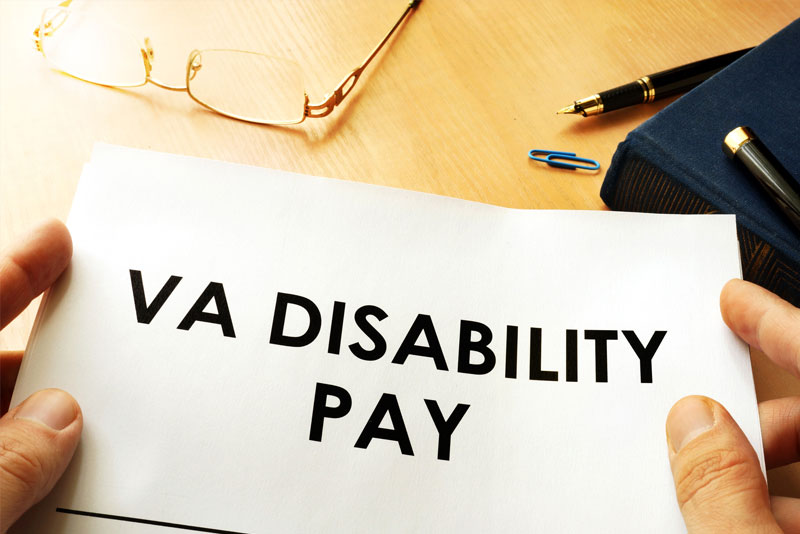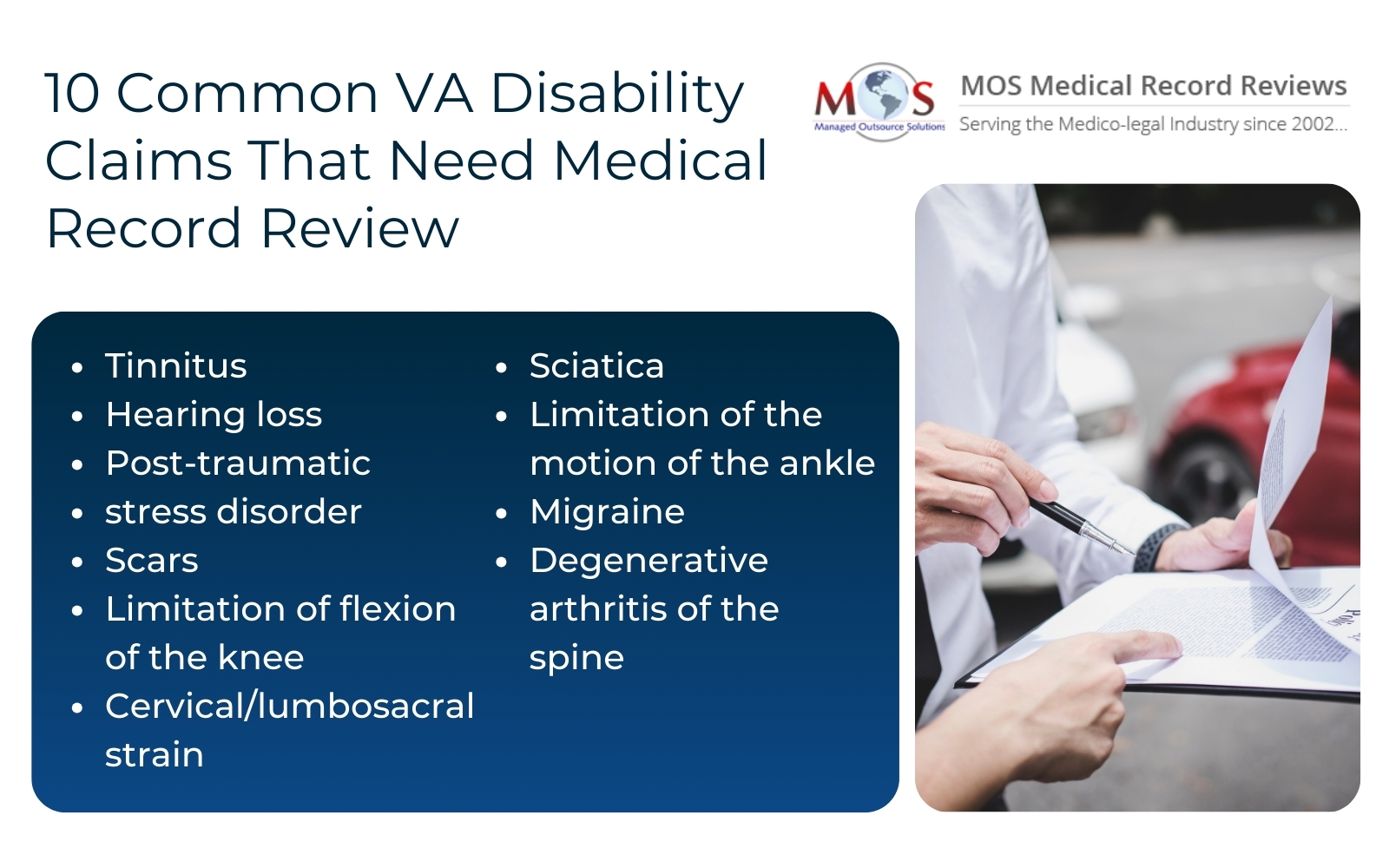U.S. veterans may be eligible for disability benefits, and the amount that may be granted is based on how the U.S. Department of Veterans Affairs (VA) rates the applicant’s service-related disability or health condition. In case the veteran has more than one service-associated disability, the monthly compensation amount will be based on his/her combined disability rating. A medical records review will be performed to establish disabling physical conditions such as an injury or a chronic illness or mental health conditions such as PTSD that developed before, during or after service. Therefore, medical records and their analysis are vital to complete a VA disability claim.
Contact MOS Medical Record Reviews for timely and accurate medical record review solutions.
Interested in Our Solutions? Call 1-800-670-2809
VA Disability Claims That Need Medical Record Analysis
- Tinnitus: It is the No.1 easiest VA disability to claim for all veterans, according to the 2018 – 2019 disability claims data. It involves the sensation of hearing sounds such as buzzing, ringing, roaring, clicking, humming or hissing even if there is no external sound present. This health condition can have only one VA rating, either 10% or nothing. In other words, there is no lower VA rating or higher VA rating and so it is called a “low value” claim. There were 157,152 compensation recipients and 93.6% of veterans were rated at 10%. Those who work in noisy conditions such as musicians, military personnel, and the elderly are most at risk of developing Tinnitus. Veterans planning to file their VA Tinnitus claim as a secondary disability need to know that conditions such as Meniere’s disease, depression and anxiety, TBI, PTSD, head and neck conditions, hearing loss, high blood pressure, and TMD or temporomandibular joint disorder can make Tinnitus worse.
- Hearing loss: Among the applicants, 93.6% of veterans were rated between 0% and 10%. To detect and diagnose hearing loss, the audiogram test is used, and the medical records should reflect this fact. The VA department would look for a certain level of hearing loss as the first step and considers two factors to rate hearing loss after the examination.
-
-
- Decibel loss at 5 different frequency ranges from low to high: To be found eligible, an average loss of 26 or more decibels in 3 of the 5 frequency ranges constitutes hearing loss.
- Speech discrimination or how well the veteran can hear normal conversation: A series of monosyllabic words is presented, and it is determined how well the veteran can hear them. A score of lower than 94% in speech recognition corresponds to a number related to hearing loss. The veteran may not be ensured compensation even if the audiogram shows that one ear is 100% deaf. The likelihood of getting benefits decreases if the hearing loss in the other ear is not significant.The second step is evaluating service-connected hearing loss. The veteran’s chances of getting disability benefits may increase or decrease based on his/her MOS (Military Occupational Specialties). An example is the job of flight mechanics. These service men have “noise exposure conceded” which means that it is understood that they were exposed to high noise levels during their service period. On the other hand, aircraft pilots whose cockpits are sound insulated may not automatically be given this concession.
-
- PTSD or Post-traumatic stress disorder: 90.7% of veterans were rated at 30% or higher for mental health; 41.1% of veterans were rated at 70% or higher, according to the 2018 – 2019 VA data. Mental health conditions such as PTSD, generalized anxiety disorder, major depressive disorder, and somatic symptom disorder are considered “high-value” claims. Such claims have a high likelihood or getting rated at 30% and above. PTSD is a mental health condition that stems from experiencing or witnessing a terrifying event. Medical records should document symptoms such as nightmares, insomnia, depression, flashbacks, anxiety, anger issues, suicidal thoughts, relationship issues and work problems. There are 37 ratable VA mental health conditions under the law under which the veteran can file a claim for disability benefits due to PTSD or any other mental health condition.
- Scars: These are 4th in the list of the most compensated claims for all veterans across all demographics. While 76.2% of veterans are rated at 0% for skin conditions and 18.6% are rated at 10%. So, scars are a low-value claim.
- Limitation of flexion of the knee: The 2018 – 2019 data showed that 92.2% of veterans were rated between 0% and 20%. This is also considered a low-value claim. Conditions that come under this include issues with joints and muscles. They must involve limitation of range of motion (flexion) and/or painful motion. Medical documentation should prove the existence of symptoms such as painful motion, loss of power, decreased movement control, fatigue, arthritis, lack of coordination, arthritis and weakness and so on. Musculoskeletal disabilities can be considered as secondary VA disability claims and these include issues with muscles.
- Cervical/lumbosacral strain: 2% of all veterans were rated between 0% and 20%, which makes this type of VA claim a low-value one. This condition signifies an injured, stretched, or torn tendon or muscle in one’s neck and is medically connected to trauma and overuse. It is represented by diagnostic code 5237 and has ratings between 0% and 100%.
- Paralysis of the sciatic nerve or sciatica: 2% of the veterans were rated between 0% and 20%, and so this also is a low-value claim.
- Limitation of motion of the ankle: Another low-value claim with 92.2% of veterans receiving ratings between 0% and 20%, VA ratings for the ankle are typically at 0% and 10%, with some rising up to 20%. A medical record review would focus on finding documentation related to arthritis, limitation of range of motion or flexion, weakness, fatigue, painful motion, lack of coordination and decreased movement control. This is a musculoskeletal disability that can also be filed as a secondary VA disability claim and can be caused or worsened by conditions such as medication side effects, post-traumatic stress disorder, depression and anxiety, and temporomandibular joint disorder among others.
- Migraine: This is a high-value claim because patients are very likely to get rated at 30% or higher. Migraine, being a serious neurological condition, is rated between 0% and 50%.
- Migraine with very frequent prolonged/prostrating attacks productive of severe economic inadaptability is rated at 50%.
- Migraine with characteristic prostrating attacks occurring on an average once a month over the last several months is rated at 30%.
- Migraine with characteristic prostrating attacks occurring on an average once in 2 months over the last several months is rated at 10%.
- Migraine with less frequent attacks is rated at 0%.
The term “prostrating” is very important in this regard because it signifies the severity or intensity of the migraine. The word shows that the migraine is so severe that the patient must lie down. A medical peer review physician evaluating the condition would look for symptoms such as nausea, throbbing pain, dizziness, and sensitivity to sound and light recorded in the patient’s medical chart.
- Degenerative arthritis of the spine: The most common type in this category is osteoarthritis, also called degenerative joint disease. The patient’s medical records should show evidence of worn out/degenerative bone, swelling, and significant pain. Other symptoms include weakness, pain, and tingling in the arms and legs. Typically, this condition receives a rating between 0% and 50%.
Medical Evidence Required to Support the VA Disability Claim
Attorneys representing veterans typically use the service provided by a medical record review company to evaluate the medical records and find evidence that can connect the veteran to the particular condition and get rated at the appropriate level to support the plaintiff’s VA disability claim or appeal. The documents required include the following.
- Hospital records and VA medical records related to the claimant’s illness/injury. Also, records that show that the claimant’s rated disability has worsened.
- Supporting statements from family and friends, law enforcement personnel, clergy members, or those whom the veteran may have served. These people can explain the plaintiff’s claimed condition and how/when it happened or got worse.
- Private hospital reports/medical records that have a connection with the plaintiff’s claimed illness/injury or that show the disability has become worse.
Proposals and Possible Changes for the Year 2025
The possible changes to VA disability benefits in 2025 may include the following.
-
-
- Cost-of-living Adjustment (COLA) increases for 2025: A considerable increase in monthly compensation rates for veterans is expected. The 2024 COLA increase trend could continue into 2025 with the economy adjusting to post-Covid conditions.
- More conditions could be added to the presumptive list for toxic exposure: Chronic respiratory diseases, neurological disorders, and more cancer types could be added to the presumptive list for veterans exposed to toxic chemicals during their service. This would enable veterans to receive disability benefits more easily without having to prove a direct connection between their disability and their service.
- Changes related to TDIU (Total Disability Individual Unemployability Benefits): It is expected that some changes may be introduced to how TDIU is awarded or evaluated in 2025. It is important that all medical records are kept up to date.
- Changes regarding VA disability ratings for mental health conditions: A rating system offering a broader range of percentages to more effectively represent the varying degrees of disability caused by mental health conditions like depression or PTSD could be implemented in 2025. Veterans may witness changes in the way their claims are evaluated.
- Changes in the timeframes and appeals process: In 2025, you could see changes intended to reduce wait times and improve the efficiency of the VA’s decision-making process. More technology-driven solutions may be implemented, and staffing could be increased in high-demand areas.
- New programs for veterans with certain disabilities: These programs could be aimed at improving care and support for veterans with specific impairments. This could include disabilities related to spinal cord injuries, traumatic brain injuries or limb amputations and other disabilities.
-
Medical records and medical record review are perhaps the most important aspects in a VA claim for disability. Solid and timely medical evidence will help establish the genuineness of the disability and convince the authorities.





